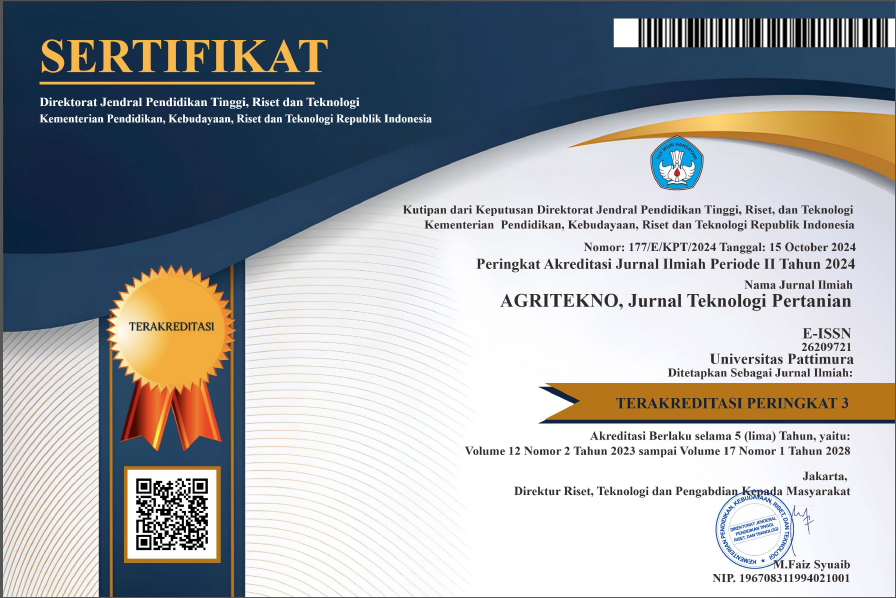Komposisi, Sifat Fisik dan Tingkat Kesukaan Nasi Ungu
Abstract
The aim of this research was to analyze the composition and physico-chemical properties of purple rice that is preferred by group of people in Bali. Purple rice were made with various pasta proportions, which were 100, 200, 300, 400 and 500 g were added to 700 g of rice. Physical properties include texture and color of purple rice with various proportion of pasta were analyzed followed by hedonic test. Parameters observed were, texture, color, and overall preference of purple rice. This research was designed as completely randomized design with 2 replicates and data of the results were analyzed using ANOVA at the significance level of 95%, followed by Duncan’s Multiple Range Test, if there was a significant difference. The results of research indicated that purple rice had texture of 2,19–2,37 N, with lightness of 42,7–54,97, tending to be blueish red (purple) with degree of redness of +8,33 until +15,13 and blueness degree of +1 until +4,60. Purple rice made from a mixture of ratio of 100 g rice: 300 g was preferred by panelists with texture of 2,26 N, lightness of 48,93, tending to be blueish red (purple) with degree value redness of +14,40 and blueness degree of +2,37.
Downloads
References
American Cancer Society. 2004. Risk of Cancer in Human Body Influenced by Food Consumption. http://www.cancersociety. com. [11 Juni 2007].
Astuti, I.B. 2005. Serat Pangan Pada Ubi Jalar (Ipomea batatas) dan Potensinya Sebagai Prebiotik Dalam Mencegah Diare Akibat Bakteri Patogen. Tesis. Sekolah Pasca Sarjana Universitas Gadjah Mada. Yogyakarta.
Fan, G., Y. Han, Z. Gu, & D. Chen. 2008. Optimizing conditions for anthocyanins extraction from purple sweet potato using response surface methodology (RSM). LWT - Food Science and Technology 41: 155–160.
Haryadi. 2006. Teknologi Pengolahan Beras. Gadjah Mada University Press. Yogyakarta.
Juliano, B.O. 1965. Rice Starch: Production, Properties and Uses. Academic press. Chemical Department, International Rice Research Institute. Philipines.
Juliano, B.O. 1994. Rice Starch: Production, Properties and Uses. Academic press. Chemical Department, International Rice Research Institute. Philipines.
Leelayuthsoontorn, P. & A. Thipayarat. 2006. Textural and morphological changes of jasmine rice under various elevated cooking conditions. Food Chemistry 96: 606–613.
Mauron, J. 1981. The maillard reaction in food: A critical review from the nutritional standpoint. Progress in Food and Nutrition Science 5: 5-35.
Meullenet, J.F., E.T. Champagne, K.L. Bett, A.M. McClung, & D. Kauffmann. 2000. Instrumental assessment of cooked rice texture characteristics: A method for breeders. Cereal Chemistry 77: 512-517.
Mu, T.H., S.S. Tan, & Y.L. Xue. 2009. The amino acid composition, solubility and emulsifying properties of sweet potato protein. Food Chemistry 112: 1002-1005.
Sulistyo, P. 2002. Perubahan Komposisi kimia, Sifat Fisik, Nilai Cerna In Vitro dan Aroma Nasi Selama Penyimpanan Dalam Magic Jar. Thesis. Sekolah Pasca Sarjana Universitas Gadjah Mada. Yogyakarta.
Putri, A.S. 2008. Komposisi, Sifat Fisik dan Antioksidatif Nasi Ungu. Thesis. Sekolah Pasca Sarjana Universitas Gadjah Mada. Yogyakarta.
Rukmana, R. 1997. Ubi Jalar – Budi Daya dan Pasca Panen. Penerbit Kanisius. Yogyakarta.
Schmild, M.K. & T.P. Labuz. 2000. Essentials of Functional Foods. Aspen Publishers. Gaithersburg, Maryland.
Soewarno, T.S. 1990. Dasar-dasar Pengawasan dan Standarisasi Mutu Pangan. Pusat Antar Universitas Pangan dan Gizi IPB. Bogor.
Sun, J.B., R.F. Severson, W.S. Schlotzhauer, & S.J. Kays. 1995. Identifying critical volatiles in the flavor of baked ‘Jewel’ sweetpotatoes [Ipomea batatas (L) Lam.]. Journal of the American Society of Horticultural Science 120: 468–474.
Whistler, R.L. & J.N. Miller. 1999. Carbohydrate Chemistry for Food Scientists. Eagen Press. St. Paul, Minnesota.
Wickramasinghe, H.A.M., S. Takigawa, C.M. Endo, H. Yamauchi, & T. Noda. 2009. Comparative analysis of starch properties of different root and tuber crops of Sri Lanka. Food Chemistry 112: 98-103.
Winarno, F.G. 2004. Kimia Pangan dan Gizi. Penerbit PT. Gramedia Pustaka Utama. Jakarta.
Yadav, B.K. & V.K. Jindal. 2007. Water uptake and solid loss during cooking of milled rice (Oryza sativa L.) in relation to its physicochemical properties. Journal of Food Engineering 80: 46–54.
Yau, N.J.N. & J.J. Huang. 1996. Sensory analysis of cooked rice. Food Quality and Preference 7: 263–270.
Authors who publish with this journal agree to the following terms:
- Authors retain copyright and grant the journal the right of first publication with the work simultaneously licensed under a Creative Commons Attribution License that allows others to share the work with an acknowledgement of the work's authorship and initial publication in this journal.
- Authors are able to enter into separate, additional contractual arrangements for the non-exclusive distribution of the journal's published version of the work (e.g., post it to an institutional repository or publish it in a book), with an acknowledgement of its initial publication in this journal.
- Authors are permitted and encouraged to post their work online (e.g., in institutional repositories or on their website) prior to and during the submission process, as it can lead to productive exchanges, as well as earlier and greater citation of published work (See The Effect of Open Access).









